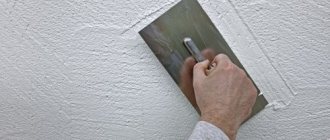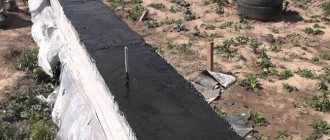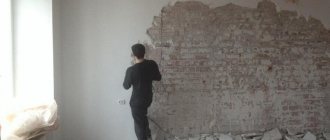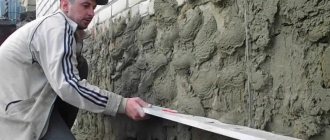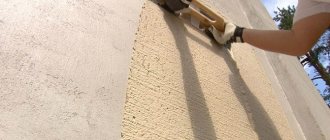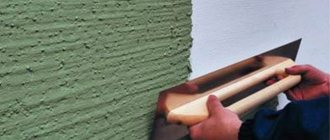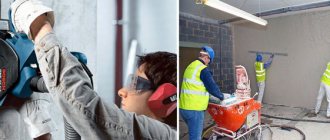Usually, beginners have difficulty choosing what is suitable for leveling walls: gypsum or cement plaster. Indeed, in order to correctly decide which plaster to choose for the kitchen or bathroom (moisture-resistant plaster is required), you need to clearly understand what the difference is between these materials, and in what conditions which is preferable.
Comparison of gypsum and cement plaster
Let's start with the fact that the properties of plastering materials largely depend on the components of the composition. It is difficult to immediately remember all the nuances of their use, so confusion is possible. Only by considering all the properties inherent in the solutions can you decide: gypsum or cement plaster - which is better for which rooms. Therefore, further we will try to make a comparison based on the main parameters determined by the properties of materials with gypsum and cement bases.
Both types of mixtures are mineral and contain three groups of components:
- binder (gypsum or cement);
- filler (usually just sand, gypsum compositions may not contain filler);
- additives that impart additional properties to the solution (plasticity, retardation of the onset of setting, antibacterial properties).
Both types of dry mixtures are mixed by adding water to form a dough (solution), which, as a result of the crystallization of binders, gains strength, turning into an artificial stone-like coating.
Both materials:
- fireproof;
- durable;
- environmentally friendly;
- unstable to vibrations and shrinkage of buildings;
- can (due to the inclusion of light filler) be heat-retaining;
- require dry storage for storage.
At this point, the main similarities give way to differences, since gypsum is an air binder, while cement is a hydraulic binder. The main difference is the reaction to the presence of water (hardened plaster, when wet, loses strength). The time to gain strength, the lifespan of the solution and other properties are also different.
Where are they used most often?
Let's consider where and which of the compositions is allowed at the place of application:
- The “hydrophobia” of gypsum sharply limits the scope of use of the material only to interior work, where dry conditions are provided for the coating. At the same time, being a hydraulic binder, cement both in the solution and in the created coating reacts favorably to moisture, gaining additional strength during hardening, without losing it when wet. Plus, cement-based compositions are frost-resistant, which is required for outdoor use. Therefore, cement is used for finishing facades, outdoor gazebos, garages, leveling wall surfaces in bathrooms, damp basements or unheated rooms.
- Gypsum material, having a lower dead weight, does not overload the ceiling and walls as much as cement. Therefore, it is used on weak foundations, on ceilings, and partitions.
- Gypsum plaster coatings are more vapor permeable than cement ones. Therefore, in living rooms where a good microclimate is required, this material is only welcome.
- On warm glazed balconies (loggias), the light weight, tenacious adhesion and plasticity of compositions with gypsum are more highly valued.
- To repair cracks in wall structures and seal joints, cement-based mortars are used, which form a more durable stone.
- Gypsum plaster, being less durable, is inferior to cement plaster where the plastered surfaces are subject to strong mechanical stress.
- Gypsum is used for puttying under paint or wallpaper.
cement plaster in the bathroom
gypsum plaster in the room
In all other cases, the two compositions do not differ in the place of application; the choice is made according to other indicators.
What grounds are they compatible with?
If the plaster is not able to hold onto the wall tenaciously, it will not last long. Therefore, the property of adhesion (strong adhesion) is important when choosing a composition. Gypsum mixtures demonstrate good “stickiness” to most base materials, therefore they are considered universal. Cement-based plaster is more capricious; it adheres less well to concrete, plastic, and painted surfaces. Being chosen for plastering monolithic or precast concrete, as well as wood, it requires additional measures to increase adhesion. The layer is also attached using reinforcing mesh, which forces the coating to increase in thickness.
compatibility of gypsum and cement plaster with bases
Material consumption and cost
Consumption is often important when choosing a plaster composition, since it affects the overall cost of repairing or leveling walls in a new building. As a rule, gypsum mixtures are used for leveling when the thickness of the adjustment layer is small; otherwise, cement mixtures are chosen. Therefore, the consumption of gypsum composition per square wall is less. With the same layer thickness, its consumption is also lower, since gypsum has the property of slightly increasing in volume when wet. When applied to a flat surface (due to workability), gypsum produces a thinner layer, therefore, consumption is reduced. You can use our calculator to calculate the required amount of mixture.
In terms of price, the composition with cement wins. The price of mixtures with gypsum (minimum) is a third higher. When making a mixture of individual materials, the price of cement-sand mortars is greatly reduced (you will find exact quantitative values in our article on the proportions of mortar for plaster), while in the case of using gypsum there will be practically no savings.
Working with gypsum and cement plaster - comparative analysis
Plasterers prefer to work with gypsum mixtures for the following reasons:
- A gypsum-based solution is lighter, so your arms and back do not get tired longer when working. This is especially important when plastering the ceiling. The sand-cement mixture is heavier.
- The solution applies well, is easy to form, and forms an even layer without much difficulty. Cement paste is more difficult to apply and shape. For adhesion, it is necessary to carry out the work in layers (for adhesion of the main layer - soil, a spray is applied). Sand grains in the solution do not allow achieving a high-quality surface without additional grouting (including coating) and grinding.
However, work with mixtures on gypsum needs to be done faster, since the setting time is short. According to this parameter, cement, as a binder, provides the plasterer with more time to work out the batch and correct possible irregularities. For beginners this is a relief.
working with cement and gypsum plaster
If we evaluate which plaster - gypsum or cement - is more conducive to reducing repair time, then here they differ from each other, since gypsum quickly gains strength and dries faster. Gypsum finishes dry in 2-7 days, cement finishes take up to 4 weeks. As a result, work times are shorter.
Features of operation
Both gypsum and cement plaster differ from each other in operation. For example, plasters with cement, unlike gypsum, can be washed. They are not afraid of strong impacts, are not prone to abrasion, and allow you to hang heavy shelves on the walls.
Cement plaster characteristics
A cement-sand mixture is a heterogeneous mass consisting mainly of cement with the addition of sand, and also various variations produced with admixtures of gypsum, limestone and other fillers. The proportions of the constituent components determine their technical characteristics and scope of application. Cement mixtures are used both for exterior decoration and indoors, and different brands, defined by numbers, are endowed with their own qualities of durability and tensile strength. The higher the number, the stronger and more expensive it is. There are a lot of varieties of this fabric.
Advantages
- Versatility.
- Durability, cement-treated walls can withstand heavy loads, you can hang anything you want, cabinets, shelves, and so on.
- Resistance to frost and sudden temperature changes.
- Durability, retains physical strength for many years.
- Moisture resistance, practically not destroyed by water.
- Not afraid of fire and flame, withstanding high temperatures well.
- Practical for leveling large slopes and curved walls.
Disadvantages of cement
- Possible formation of cracks after drying, such consequences arise as a result of incorrect proportions or shrinkage of the building.
- It is not a finishing coating and requires additional leveling.
- After drying, irregularities form, which is natural during rough finishing.
- The solution takes a long time to dry and gains strength over several days.
- Complex installation process.
- High consumption during application.
- A load is created on the wall due to the large weight of the material itself.
Also read: Vinyl or non-woven wallpaper, which is better?
Based on these characteristics, we analyze and draw a conclusion. This mixture is suitable for rough preparatory work, construction of wall structures, foundations, reinforced concrete buildings, bonding brickwork, in finishing unheated and damp rooms, such as bathrooms or basements, and is a solid foundation for further finishing work.
Leveling walls with sand and cement mixture
The solution is prepared by diluting sand with cement, in certain proportions recommended by the manufacturer, usually one part cement, three parts fine sand. Dilute with water and mix with a shovel until a homogeneous consistency, or with a mixer, then infuse for up to two hours.
- The walls do not require additional preparation; it is enough to knock down large bumps and bulges. To form a high-quality foundation, it is advisable to install beacons along a vertical plane with a step between them of up to a meter. This is done using metal profiles, which are glued to the wall with gypsum glue and leveled with a rule and level. You can learn how to plaster walls using beacons in this article.
- When the surface has significant slopes, it is advisable to use a reinforcing mesh; it is applied to the entire base and secured with hangers, after which the beacons are installed, and the leveling process proceeds.
- The wall is moistened with water and a mixture of cement is applied in pieces to the wall between the beacons in small sections, and using the rule, using oscillating movements, we rub the solution over the surface, from bottom to top, and continue to fill subsequent sections.
- Having completed one interval, wait a little while for the layer to dry and run the rule along the entire line, cutting off the excess, and move to another section performing the same actions.
- In some cases, application is carried out using reinforcement, and always in several layers.
- For better smoothing, wait until it dries slightly and use a more liquid solution to rub the defects with a spatula, over the entire surface without strong pressure, sliding over the coating in a circular motion.
Features of cement plaster
The class of cements includes more than a dozen varieties of binders. The main material for plasters is Portland cement. Cement-based mortars require moist conditions to harden. If this is not ensured, the resulting stone lacks strength and cracks. Mortars differ according to their construction and operational characteristics (workability, strength, frost resistance, adhesiveness, etc.).
Cement combines well with other binders (except gypsum). For example, to increase plasticity, lime is added to the composition. Polymer binders add elasticity to cement stone (the ability to resist vibration and shrinkage). The solution easily “shares” moisture with the absorbent base, so a primer barrier is required.
The properties of the mixture are also affected by the roundness or angularity of the sand grains (workability, amount of shrinkage). Perlite sand, sawdust and other fibers are used as filler (increasing heat-protective functions, micro-reinforcement). Modifying additives provide additional properties or enhance existing ones. For example, the introduction of anti-frost additives makes it possible to plaster facades in winter.
Advantages of cement plaster
Among the advantages, we note those due to which cement compositions do not lose popularity:
- coating strength (depends on the brand of solution, conditions of preparation, application, hardening);
- resistance to moisture, water resistance (solutions are used for plastering swimming pools);
- together with additional measures, it is possible to achieve high adhesion strength to the base;
- relatively affordable cost and wide presence on the market.
Disadvantages of cement plaster
Disadvantages that have to be mitigated:
- long-term strength development (modern mixtures contain additives that reduce time);
- good adhesion is not possible with all materials (does not adhere to plastic, painted surfaces, wood);
- “heaviness” does not allow use on weak bases, or forces you to reduce the thickness of the coating;
- the complexity of plastering work (multi-layer coating, special care during hardening, etc.);
- It is difficult to achieve a surface smooth enough for wallpapering or painting (puttying is required).
defects in cement plaster
Features of gypsum plaster
Obtained by dehydrating natural gypsum, the powder quickly forms crystals and hardens when diluted with water. Virtually no shrinkage. For hardened gypsum plaster, the effect of water is destructive. The fineness of the powder, similar to flour, makes the dough especially pliable, easily filling the recesses of any configuration. Does not release water to the base, retaining the necessary liquid in itself.
The plasticity of the mixture allows you to obtain even, smooth surfaces without much effort. The dough is “convenient” for plastering hard-to-reach areas. Gypsum is combined with lime. In factories, mixtures are produced that combine gypsum with cement, but this cannot be repeated at home.
The peculiarities of the crystal formation process impose restrictions not only on the lifespan of the solution. Do not return residues removed from the wall or lumps that have thickened on a spatula to the container with the working solution. Also, you should not mix a new portion in a container that has not been washed from the remnants of the previous solution. Such “old lumps” become grains of crystallization and sharply accelerate the setting of fresh dough. The mass is kneaded in cold water.
Advantages of gypsum plaster
Note that gypsum plaster:
- light in weight (suitable for application on weak substrates);
- creates an optimal microclimate;
- porosity promotes the breathing of walls, maintaining their dryness and longevity;
- keeps warm;
- does not form cracks during curing;
- does not need puttying;
- easy to sand.
Disadvantages of gypsum plaster
Let's look at how this type of mixture differs from cement from a negative perspective:
- not waterproof (as a result - use only in interiors, cannot be washed without a waterproof coating (easily abraded, scratched and chipped);
- costs more (sometimes 1.5-2 times);
- has low strength.
defects in gypsum plaster
Gypsum plaster characteristics
In such a solution, the main composition is gypsum. Unlike the sand-cement mixture, it has a finer grain structure. The composition also includes various fillers that increase strength, expanding the possibilities of use in different rooms. Gypsum is a well-binding natural material with a number of advantages. For example, rot-band, one of the varieties of gypsum mortar, which has become widespread due to its distinctive qualities and decent strength.
pros
- Excellent adhesion, grips on any surface.
- Suitable for pre-finish leveling of walls.
- The mixture is easy to use, easy to apply and more pliable.
- Creates a better sound barrier and thermal insulation layer compared to cement.
- Low consumption of the mixture; in some cases, a single layer application is sufficient.
- No shrinkage, due to the characteristic plasticity, cracks do not appear.
- Breathable natural material capable of absorbing and releasing moisture, maintaining a favorable internal microclimate.
- They withstand frost and temperature changes well and are not destroyed by their influence.
- Easier to dismantle when it is necessary to replace and repair the plaster layer.
Also read: What are 3D panels?
Minuses
- High price compared to cement.
- Strength to mechanical stress is lower.
- Before application, additional treatment of the base with primer is required.
- Not used for exterior decoration (some varieties).
- Lower moisture resistance, but acceptable for use in rooms with high humidity.
Gypsum mixture is considered a more modern type of building material; it is more often used when leveling the surface, creating a distinctively smooth surface ready for finishing; it is not used for constructing a wall structure. It comes in fine, medium and coarse grain. For example, a composition with a finer fraction is better suited for perfectly leveling walls, while a coarse-grained one is used to correct significant unevenness. The most common structure is a medium-grain mixture, the most versatile product is suitable in both cases. The mixtures also differ in their moisture-resistant characteristics, offering separate product lines for dry and wet rooms.
Leveling walls with gypsum plaster
The mixture is offered in ready-made liquid form and is more expensive, or, more often, in a dry version, which is diluted with water and mixed using a construction mixer.
- Thanks to its good adhesion, the gypsum mixture can be used on any surface; large irregularities and chips are covered with a cement mixture or the same gypsum mortar, then the walls must be treated with primer.
- To create a better and even surface, beacons are used, all work and wall leveling technology are carried out in the same way as with a cement mixture.
- The finished solution dries quickly, so work is carried out quickly. Repeated dilution with water when drying is unacceptable, since the material completely loses its properties.
- When applying, it is not necessary to use reinforcement, which makes the work process easier, except for particularly thick layers.
- The material is quite flexible, ease of use ensures the creation of an even layer and, depending on the structure and fraction, is subsequently suitable for finishing manipulations with other coatings. Applying one layer or maximum two is enough.
- It is applied with a spatula and easily leveled using a rule, after which we wait for it to dry and the wall is rubbed down. We wet the surface and rub it with a special grater, achieving a smooth surface. After installation and drying, they go through sandpaper to remove roughness.
- Gypsum mortar is easy to process corners, door and window openings, and create geometric shapes and curves. Due to the flexibility and adhesiveness of the solution, it is ideal for sealing individual areas.
Also read: Aprons for the kitchen; material and design options
Combination of gypsum and cement
The question of the possibility of applying a gypsum mixture to a cement mixture (and vice versa), as well as mixing the compositions, is easier to clarify by mentioning the cement bacillus. When sulfate ions SO get into the cement solution, an insidious mineral for it - ettringite - is formed in the body of the cement stone. “Novichok”, formed during the hardening period, contains crystallized water. If, after the formation of a stone, moisture gets inside it, the mineral “swells,” tearing the stone.
Wanting to make plastering easier, by mixing solutions based on cement and gypsum, after applying such a mixture to the wall, a “mine” is obtained, the effect of which is delayed in time. As long as moisture does not penetrate into the ettringite area, the bacillus “sleeps.” As soon as water gets in (which often happens where it is damp or during flooding), the mineral increases 2.5 times, and the stone becomes covered with a network of cracks.
Therefore, it is worth excluding any possible combination in the finishing of mortars on gypsum and cement:
- do not apply plaster with cement onto a coating containing gypsum and vice versa;
- avoid leaving lighthouse gypsum fastenings when plastering with mortar on cements;
- Do not use tile cement adhesive over gypsum plaster.
Prevention is as follows:
- select materials with the same binder for the neighborhood;
- if it is impossible to avoid this combination, place a layer of waterproofing between them (on a cementless basis);
- To reduce the porosity of the coating, reduce the amount of water in the dough.
One more rule. A layer of the same strength or weaker material is applied to the weak material. Gypsum is not applied over cement, even with intermediate waterproofing.
Composition and features of gypsum plaster
Gypsum plaster
- This is a whole group of ready-made mixtures used primarily for interior decoration of rooms with normal humidity conditions. It is easy to guess that the main binding component here is gypsum powder. It is obtained from a natural mineral that is pre-heated and crushed. To reduce consumption, give the mixture strength and improve adhesion, natural or synthetic fillers and polymer additives are used.
Gypsum mixtures are supplied in different packaging, they are completely ready for use, for which you just need to add the required amount of water. The “fat content” of the solution and its scope of application depend on the amount of liquid. If it is necessary to repair a crack in the wall, the amount of water added should be minimal. For finishing (decorative plaster), the solution must be quite liquid and spread well on the wall.
conclusions
Taking into account the above, we choose which (gypsum or cement) plaster is more rational to use for each room, and not for the whole house at once. The finishing must correspond to its purpose (protection and alignment of walls), as well as the conditions of a particular place (room). This is due to the properties and characteristics of the plaster compositions. Taking them into account will make it possible to produce a plaster coating that is durable, strong, and reliable. And such work will not cost that much.
Considering what is better - gypsum or cement plaster, we came to the conclusion that the one that suits both the purpose and the place is better.
